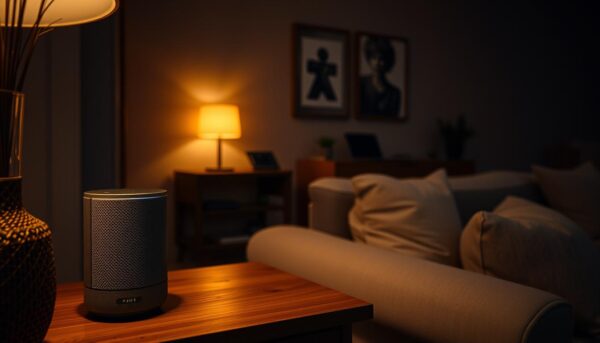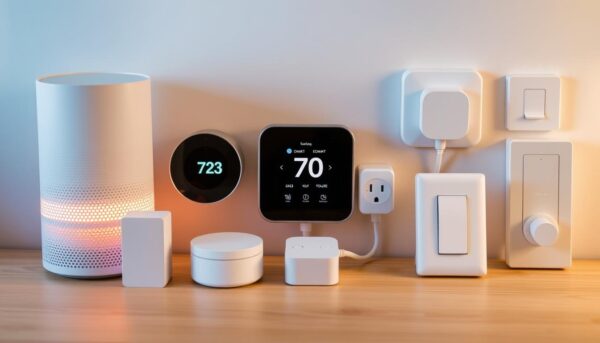✅ Last checked on
Imagine controlling lights, adjusting thermostats, or locking doors with simple voice commands—even during an outage. Traditional systems rely on cloud servers, but what if you could break free from that dependency? Platforms like Rhasspy and Open Voice OS let you build a self-sufficient setup that prioritizes privacy and speed.
Take Calvin Wankhede’s experience: he transformed a Raspberry Pi into a hub using Home Assistant. His lights, fans, and security cameras now respond instantly to local commands. No lag. No data leaks. Just direct control over your environment.
Cloud-based tools often fail when Wi-Fi drops or servers crash. Local systems eliminate these risks. They process requests on-device, keeping your information secure. Plus, automation rules run smoother without waiting for external connections.
Key Takeaways
- Create a self-reliant system using Rhasspy or Open Voice OS for instant responses.
- Home Assistant on devices like Raspberry Pi enables seamless device management.
- Local processing enhances privacy by avoiding cloud data storage.
- Overcome internet outages and server delays with on-device automation.
- Voice recognition works faster without relying on remote servers.
Understanding the Offline Voice Assistant Smart Home
What if your lights turned on before you said “Alexa”? Traditional setups need constant web access, but self-hosted systems cut the cord. Unlike cloud-dependent tools, these setups process commands directly on your hardware—no third-party servers involved.

How Do Self-Controlled Systems Work?
Local automation uses software like Home Assistant to manage devices through your home network. For example, motion sensors can trigger lights without sending data online. Setting up a smart home hub lets you create rules that run instantly, even during outages.
Why Keep Everything In-House?
Local processing means faster responses and tighter security. Calvin Wankhede notes, “My camera feeds stay inside my network—no risk of leaks.” Here’s how it stacks up against cloud services:
| Feature | Local System | Cloud System |
|---|---|---|
| Data Storage | On your devices | Remote servers |
| Internet Dependency | Optional | Required |
| Response Time | Instant | 1-3 seconds |
Tools like Rhasspy handle voice commands without Google or Amazon. You say “play music,” and your stereo responds—no middleman. This approach also reduces hacking risks since there’s no cloud account to breach.
Why Go Local? The Advantages of a Fully Offline Smart Home
Taking charge of your home’s automation brings more than convenience—it offers independence. Local systems let you bypass cloud servers entirely, keeping operations fast and private. Let’s explore how this approach strengthens security, uptime, and your budget.
Lock Down Your Data
Cloud-based setups store your routines on remote servers. Calvin Wankhede’s setup with Home Assistant proves local processing keeps camera feeds and voice commands within your network. “No third parties means fewer attack vectors,” he explains. Every automation runs on your hardware, reducing exposure to breaches.
No Internet? No Problem
When storms knock out Wi-Fi, cloud systems freeze. Local setups keep lights and thermostats responding instantly. Automations trigger through your hub—not a distant server. This reliability matters for security cameras or medical devices that can’t afford delays.
Save Money Long-Term
Retrofit existing appliances with $15 smart plugs instead of buying new “connected” products. Avoid monthly fees from services like Alexa Guard. One user slashed costs by 60% using Zigbee sensors with Home Assistant. Compare the economics:
| Expense | Local System | Cloud System |
|---|---|---|
| Hub Hardware | $50-$100 | $0 (but requires existing devices) |
| Monthly Fees | $0 | $5-$30 |
| Device Compatibility | Works with older gear | Often requires new purchases |
Years ago, limited device support made local setups challenging. Today, platforms integrate with 1,000+ products—from Philips Hue to obscure sensors. You control everything without code or complex configurations.
Essential Hardware and Devices for Your Local Setup
Your hardware choices make or break a self-reliant automation system. Start with a reliable hub—the brain of your operations—and layer compatible sensors and modules. These components work together to interpret commands and trigger actions without external servers.

Choosing the Right Hub and Sensors
Calvin Wankhede’s Raspberry Pi 4 setup handles 30+ devices, but newer options like Home Assistant Green offer plug-and-play simplicity. Key factors:
- Processing power: 2GB RAM minimum for smooth automations
- Storage: 32GB microSD cards handle logs and updates
- Expandability: USB ports for Zigbee/Z-Wave sticks
“I tested three hubs before settling on Odroid-N2+—it’s silent and handles 4K video feeds.”
Pair your hub with motion sensors ($12-$40), door/window detectors ($15-$25), and smart plugs ($10-$35). Philips Hue bulbs and IKEA Tradfri outlets work reliably via Zigbee. Shelly Wi-Fi devices offer budget-friendly alternatives.
Protocol Integration Made Simple
Mix Zigbee, Wi-Fi, and Z-Wave devices through a single hub. This table shows their strengths:
| Protocol | Range | Power Use | Best For |
|---|---|---|---|
| Zigbee | 40-60m | Low | Sensors, lights |
| Wi-Fi | Depends on router | High | Cameras, plugs |
| Z-Wave | 100m+ | Medium | Security systems |
Use a $35 Sonoff Zigbee 3.0 dongle to connect 100+ devices. For Wi-Fi gear, VLAN segmentation keeps traffic local. Brands like Aqara and Third Reality offer multi-protocol devices that simplify setups.
Setting Up Rhasspy and Open Voice OS for Local Voice Control
Unlocking local voice commands starts with choosing the right tools and configurations. Rhasspy and Open Voice OS let you bypass cloud servers entirely, turning your hardware into a responsive command center. This setup ensures your routines stay private and lightning-fast.
Installation and Hardware Requirements
Begin with a Raspberry Pi 4 or mini PC running Linux. Install Rhasspy via Docker for simplicity—it handles dependencies automatically. Aim for at least 2GB RAM and a 16GB SD card to manage voice models smoothly. For clear audio, pair a ReSpeaker microphone array ($35) to reduce background noise.
Configuring Voice Commands and JSON Triggers
Define phrases using Rhasspy’s web interface. For example, “Turn on the kitchen lights” maps to a JSON event. Here’s how commands translate to actions:
| Voice Command | JSON Trigger | Action |
|---|---|---|
| “Start movie mode” | {“intent”: “MovieMode”} | Dim lights, lower blinds |
| “Goodnight” | {“intent”: “Sleep”} | Lock doors, set thermostat |
Test patterns with the built-in simulator. Adjust sensitivity if the system mishears phrases like “play music” versus “pause music.”
Connecting to Home Automation Platforms
Link Rhasspy to Home Assistant via MQTT. Enable the integration in Settings > Add-ons, then create automations triggered by JSON events. Calvin Wankhede shares: “My ‘coffee time’ command starts the brewer and reads news—all without code.”
For Zigbee devices, use ZHA (Zigbee Home Automation) in Home Assistant. Troubleshoot failed connections by checking MQTT broker logs or adjusting wake-word sensitivity. The community forum offers scripts to sync devices across platforms like Node-RED.
“Local setups thrive when you start small—master one room before expanding.”
Comparing Local Voice Systems with Mainstream Smart Home Tech
Why settle for delayed responses and privacy concerns when alternatives exist? Self-hosted systems process commands directly on your hardware, while mainstream options route every request through distant servers. This fundamental difference impacts speed, security, and reliability in daily use.
Local AI and Offline Functionality vs. Cloud Dependency
Cloud-based platforms like Alexa require constant web access to interpret basic commands. Local tools analyze speech patterns on-device using compact language models. One user reported 0.2-second response times for lighting controls with Rhasspy—five times faster than Alexa’s average.
Internet outages cripple cloud-dependent setups. During a recent ISP outage, a Reddit user’s Open Voice OS system continued adjusting thermostats and playing music locally. Their neighbor’s Google Nest devices became expensive paperweights.
| Aspect | Local Systems | Cloud Systems |
|---|---|---|
| Command Processing | On-device | Remote servers |
| Internet Required | No | Yes |
| Average Latency | <0.5s | 1.5-3s |
Rhasspy, Open Voice OS, and Beyond
These platforms support 20+ languages without monthly fees. Calvin Wankhede configured Open Voice OS to control Zigbee lights and Wi-Fi cameras through Home Assistant. “My custom wake word eliminates accidental activations,” he notes.
Future updates focus on edge-AI improvements—smaller models that run on $15 microcontrollers. How-To Geek highlights upcoming features like visual recognition for security cameras without cloud processing.
Mainstream speakers often require new device purchases. Local solutions retrofit existing gear through universal protocols. A $35 Raspberry Pi can replace $200 smart speakers while offering deeper automation capabilities.
Conclusion
Creating a self-reliant automated environment puts you back in charge—no compromises. Platforms like Rhasspy and Open Voice OS prove that modern home automation thrives without cloud dependencies. Your data stays private, commands execute instantly, and devices respond even when the internet falters.
Hardware like Raspberry Pi paired with Home Assistant forms a robust foundation. Community-driven integrations support thousands of products, from basic lights to complex security systems. This approach eliminates monthly fees and forced upgrades that plagued setups years ago.
Future advancements in local AI will refine recognition accuracy and expand capabilities. Already, these systems handle tasks faster than Google Assistant while keeping your connection secure. Developers continuously optimize code, ensuring smoother control for all users.
Ready to redefine your space? Start small—experiment with voice commands for a single room. The flexibility of open-source tools empowers people to build tailored solutions. Your journey toward a truly independent smart home begins today.